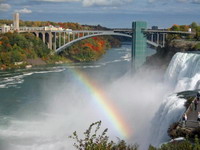Login form
New York

New York is nicknamed the Empire State. The nickname may have started with George Washington, the first president of the United States. Washington is supposed to have predicted that New York would become the center of a great empire. That empire was the newly formed United States. Washington was right. New York became one of the most influential and important states.
A LEADER AMONG THE STATES
New York led the states in manufacturing and population from the early 1800s until the 1960s. That’s when California overtook it. But New York is still an industrial powerhouse, and it ranks third among the states in population. Today, California and Texas both have more people than New York.
About half of New York’s people live in or near New York City. New York City is not just New York’s biggest city. It’s the biggest city in the United States and the fourth largest city in the world!
New York was one of the original 13 English colonies. On July 26, 1788, New York became the 11th state to join the United States. Its capital is Albany. Both the state and its capital are named after the duke of York and Albany. The duke became King James II of England in 1685.
NEW YORK CITY
Washington, D.C., is the center of the nation’s government. But New York City is the center of most other activities. The city’s Wall Street is the nation’s center of banking and finance. Theaters, concert halls, museums, and galleries make it America’s cultural center. The city is also a fashion center, a trade center, and a business center.
The United Nations has its headquarters in New York City. This international organization, which works toward a more peaceful world, links New York City with the rest of the world.
HILLS, MOUNTAINS, AND BEACHES
New York beyond the New York City area is referred to as “upstate.” Upstate New York provides quite a contrast to bustling, crowded New York City. When you leave the city, you’ll find rolling hills dotted with dairy farms, tall mountains, small towns, and many lakes.
The eastern part of New York State is mountainous. Central and western New York are mostly hilly. Eleven long, narrow lakes lie in the hills of central New York. They’re called the Finger Lakes because that’s what they look like. These hills, mountains, and lakes have many resorts and recreation areas.
For beaches, there’s Long Island, a part of the state that sticks into the Atlantic Ocean. A ribbon of sand on Long Island’s southern shore forms Fire Island National Seashore. It’s the best-known beach on Long Island, but there are many others. On summer weekends, many residents of New York City head for towns near Long Island’s beaches.
CATSKILLS AND ADIRONDACKS
The Catskill and Adirondack mountains are popular spots for summer camps and vacation resorts in upstate New York. The Catskill Mountains rise west of the Hudson River near Albany. It’s a scenic area of tree-covered mountains, deep valleys, lakes, streams, and waterfalls.
The Adirondack Mountains are farther north. They extend almost to Canada. The Adirondacks are far more rugged than the Catskills, and they have hundreds of lakes. Adirondack Park is the largest state park in the United States. It’s a great place for hiking, canoeing, and camping.
NIAGARA FALLS
Niagara Falls is one of the most popular tourist sights in the United States. It’s on the Niagara River along New York’s border with Canada. The Niagara River plunges over a cliff to create Niagara Falls.
Millions of tourists visit Niagara Falls every year. It’s one of the most spectacular waterfalls in the world. Many waterfalls are higher, but few carry so much water or make such a loud roar.
Part of Niagara Falls belongs to the United States, and part belongs to Canada. You can walk through tunnels to a cave beneath Niagara Falls, or take a boat ride to the bottom of the falls
HUDSON RIVER AND ERIE CANAL
The Hudson River has been key to New York’s influence and growth. It starts in the Adirondack Mountains and flows into the Atlantic Ocean. It connects New York City with upstate New York.
The Hudson River’s importance grew in 1825. That’s when the Erie Canal was finished. The Erie Canal connected the Hudson River with the Great Lakes. Goods from Ohio and farther west could now reach the Hudson River and then the Atlantic Ocean. Goods could travel the other way, too. New York City thrived as a seaport because of the canal.
At the time, there were few roads, and it was costly to ship goods over land. Shipment by water was cheaper and faster.
BUFFALO AND ROCHESTER
The Erie Canal helped build the cities of Buffalo and Rochester. They are New York’s second and third largest cities. The Erie Canal ends at Buffalo, a port at the eastern tip of Lake Erie.
Buffalo is known for its heavy snow in winter. It’s also known for Buffalo wings. These spicy chicken wings started out as a favorite snack food in Buffalo. They’ve become popular across the United States. In 2002, Buffalo started an annual Buffalo Wings Festival. It’s held on Labor Day weekend in September, and features cooking contests and a wing-eating contest.
Rochester is known for making cameras. George Eastman founded the Eastman Kodak Company here in 1880. Today, his house is a museum of photography.
COOPERSTOWN
According to legend, baseball was invented by Abner Doubleday in Cooperstown, New York. Nobody knows for sure if this story is true, but today Cooperstown is the home of the National Baseball Hall of Fame and Museum. People come here to learn about baseball’s history and greatest players. Each year, a few more great players are elected as new members of the Hall of Fame.
Source: Microsoft ® Encarta

